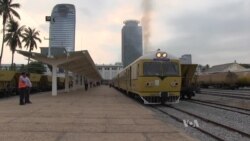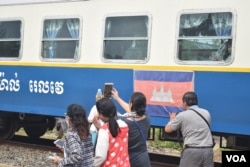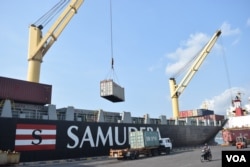It’s been nearly 13 years since a passenger train last departed from Phnom Penh’s train station. But after years of refurbishment works along the country’s dilapidated southern line, more than 170 eager travelers boarded the 7am train on Saturday to take the scenic eight-hour maiden trip to the coastal town of Sihanoukville.
“I think it is a good alternative transportation to a bus, a car or airplane, and I think the train is safer than a bus,” said Putserey Roth, an excited train traveler.
This voyage was the first in a weeklong trial that its operators, Royal Railway, hope will spark enough interest to pave the way for a regular daily service.
While the sold-out 266-kilometer journey marks a small step forward for the country’s tourism sector, the railway line began commercial operations in 2013, providing a much needed transport option for Cambodia’s freight sector, whose infrastructure needs are struggling to keep up with the country’s fast growing economy.
Struggling to keep pace
For over a decade Cambodia’s economy has grown at an average of close to 7 percent.
Expansion plans are underway at the Phnom Penh and Sihanoukville ports. The capital’s airport has recently undergone an upgrade and roads are constantly being developed and rebuilt, with the government having targeted priority areas for development.
Experts, however, say that seeking funding for the infrastructure needs to support trade over the next decade will be a challenging task.
According to the Jakarta-based Economic Research Institute for ASEAN and East Asia, from 2013 to 2022, Cambodia will require between $13 billion and $16 billion in infrastructure investment – from roads and railways, to power plants and ports – if it is to maintain its growth trajectory.
Driven by worldwide exports in Cambodia’s garment and rice sectors, as well as new car imports demanded by the country’s emerging middle class, Phnom Penh Dry Port has rapidly increased it’s rail freight between the capital and the country’s largest sea port in Sihanoukville, from 50 containers a month when it first started three years ago to more than 2,500 per month today.
“The business is growing, it is about proving to people that we are safe, reliable, and above all we don’t have any theft,” said John Guiry, Chief Executive Officer at Royal Railway, whose company runs two to four trains per day, depending on demand.
“As people get used to using rail, the business will continue to grow,” he said.
Logistics suffering
Yet experts say there is still much to do to bring down costs across all forms of transport, from waterways, to inland trucking, rail and even air freight.
While there have been improvements in customs clearing times, according to the World bank, Cambodia’s weak logistics mean that export costs are 30 percent higher than neighboring Thailand and Vietnam.
David Van, of business advisory firm Bower Group Asia, who has played an active role in Cambodia’s rice and garment industry for over a decade, says that the waterways flowing through the country are underutilized and there is too few businesses in the trucking industry.
He said the government needs to offer up more financial incentives such as tax breaks and short-term tax holidays to entice investors. “In order to attract foreign or local investment, into this kind of heavy, capital intense infrastructure, it goes back to the same song that people keep singing: 'what are you providing me in terms of fiscal incentives?'”
Government called to action
As the country edges closer towards middle-income status, its potential to attract aid in order to support infrastructure needs is reduced.
This, according to economist and senior government advisor Mey Kalyan, has the government eying new sources of funding - from accessing assistance from the recently formed Asian Infrastructure Investment Bank (AIIB) to planning for the issuance of a future sovereign bond.
The government is also working to enhance its standing among infrastructure investors with the development of a policy for public private partnerships (PPPs). These contracts vary from project to project, but often involve the private entity building and operating anything from a power plant, to a road or a railway line, over a long term.
Since the 1990s, Cambodia’s government has entered into several PPPs, largely in the power sector - in hydro dams and coal plants, although many of these deals have been negotiated behind closed doors.
But according to Kalyan, following their narrow victory in the 2013 election, the ruling Cambodia Peoples Party recognizes that voters expect more.
The government must open up, he says, to win the trust of the private sector and lure the investment it needs to underpin the growth that improves the livelihoods of everyday Cambodians.
“[PPPs] have to be negotiated in a very transparent way, and for that we need an institution which is capable, and honest and with integrity. I think there is no doubt about that,” he said.













